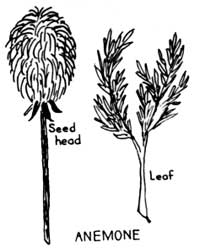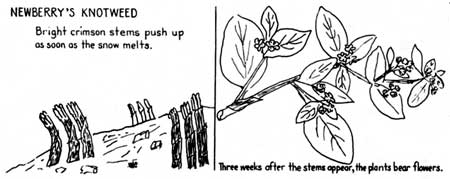|
Volume XIX - 1953
Crater Lake Discovery Centennial
Crater Lake Wildflowers And Their Rapid Growth
By Joseph Burgess, Ranger Naturalist

At elevations from 6000 to 8000 feet, like those near the Rim of
Crater Lake, winter weather exists during a major portion of the year.
Records kept in the Chief Ranger's office show snow on the ground from
October until June with snow often recorded in September and sometimes
remaining until July. Compared with the season of 1951 - 52, when
snowfall was almost a record, the total reaching 835 inches, (Hallock,
1952) only 571 inches were recorded for the year of 1952 - 53. Of this
amount, 6.8 inches fell in June and approximately 108 inches remained on
the ground at the Rim Campground July 1st. Hence the late season. The
Rim road around the Lake was not completely opened until July 30th and
the trail to the Lake, August 1st.
On the bank bordering the Sinnott Memorial walk, snow disappeared
July 10th. Twenty days later, prickly currant, Ribes
lacustre Poir, had put on new leaves and a profusion of greenish
pendulous flowers.
The smooth wood rush, Luzula glabrata Hoppe, cannot wait for
the snow to melt but sends up bright green, grass-like leaves through
the thinning snow, often while it is three inches deep. This plant
is a perennial, the stoloniferous stems staying alive underground during
the long winter months.
The western windflower, Anemone occidentalis Watson, is
not-able for it's quick appearance when the snow melts. In less than a
week the finely divided leaves appear, and two weeks later the flower
stem is crowned with a white flower, the center filled with canary
yellow stamens. This in turn is short lived, and the attractive greyish
seed head, resembling a wind blown cloud, takes its place. Like so many
members of the buttercup family, the flower has no petals - - the showy
sepals taking their place.

For speed in completing its annual cycle, one must mention one of
the commonest of Crater Lake flowers, Newberry's knotweed, Polygonum
Newberryi Small. The history of several recorded plants on the
Garfield Peak trail was as follows: Two days after the snow melted back,
bright red stems pushed through the drying soil. A week later green
leaves were in appearance, and the plant was about three inches tall.
Seven days later, short spikes of greenish flowers were showing, and the
plant had attained the apex of its flowering season just 24 days
after the bright red stems pushed through the earth. Very quickly
the green chlorophyll in the leaf disappears, and the hillsides are
brightened by the red and orange tints of this fast growing little
knotweed. This is just another of the many plants which take advantage
of the brief hours of summer sunshine to complete their short yearly
cycle before autumn frost and snow terminates activity for another
year.
Reference
Hallock, Louis W. 1952. The big snow of 1951-52. Crater Lake
Nature Notes 18:3-5.
|

